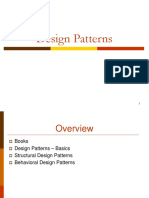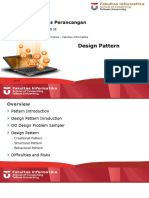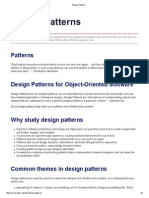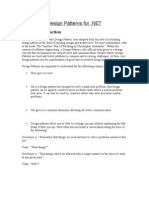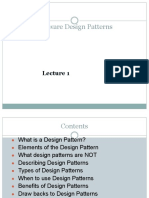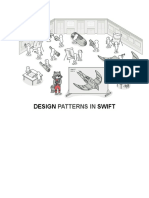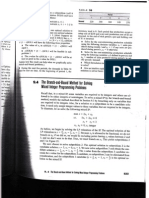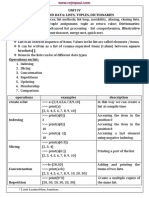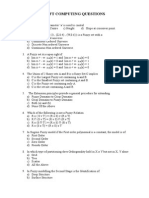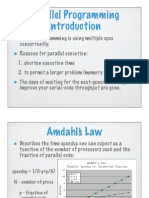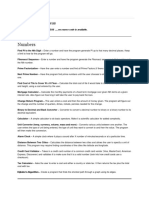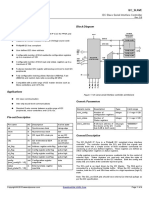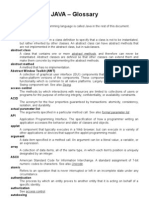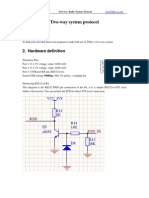Design Patterns
Reading 1
Object Oriented Design and Patterns
Chapter 5: Patterns and GUI Programming
5.1. Iterator as a Pattern
5.2. The Pattern Concept
5.3. The OBSERVER Pattern
5.4. Layout Managers...
5.5. Components, Containers,...
5.6. Scroll Bars and DECORATOR
5.7. How to Recognize Patterns
5.8. Putting Patterns to Work
This reading is required and will be covered on
quizzes and exams
�Reading 2
Game Programming Patterns
Introduction
Architecture, Performance, and Games
Design Patterns Revisited Command
This reading is required and will be covered on
quizzes and exams
�Overview
A design pattern is a way of solving a problem that
occurs repeatedly in a single program, or
commonly in many programs
Patterns allow us to decouple program elements,
giving us specific conceptual advantages
The patterns we will discuss now include
COMMAND, ITERATOR, FACTORY METHOD,
OBSERVER
Model View Controller architecture is a way of
separating functionality in GUI programs that uses
the OBSERVER pattern
�Why?
Why study design patterns?
We've all worked with poorly designed code bases
The appropriate question is "why study software
architecture?"
Small changes cause a cascade of bugs in other parts
of the software
Large changes are difficult or impossible because the
code base is too complex and poorly structured for one
programmer to grasp
What about well designed code bases?
Small changes are easy and quick
Large changes are made easier because the
architecture is decoupled and well documented
See excerpt from GPP
�Scenario
Your boss asks you to fix a bug
Your software uses a linked list to store data
But the program bugs out whenever it has to access the
data at two points at the same time, which is required
for a new feature being built by someone else
Your task is to allow two or more simultaneous access
points into the linked list
How do you do it?
�What is a Design Pattern?
�A Pattern Language: Towns, Buildings, Construction
In 1977, architect Christoph Alexander (and others)
published a book called A Pattern Language:
Towns, Buildings, Construction
This book described strategies for solving common
architectural problems
It described a step-by-step process to design and
construct buildings according to the needs of its users
AND it described common problems in all building
projects, with ways for solving them
These are called design patterns
It described 253 patterns, which together form a pattern
language a language of strategies for solving design
problems
Design Patterns
Design patterns in any domain have two basic
parts
1. The problem (or context)
2. The solution
The problem and solution are stated generally, to
apply to all varieties of a reocurring situation
Christoph Alexander: "Each pattern describes a
problem which occurs over and over again in our
environment, and then describes the core of the
solution to that problem, in such a way that you can use
this solution a million times over, without ever doing it
the same way twice."
�Pattern 23: Parallel Roads
Alexander's patterns dealt with problems of
designing communities or campuses
Problem: Grid layout of roads leads to traffic
congestion and gridlock
Solution: Use long, parallel one-way roads
Keep parallel roads around 100 yards apart to allow use
of the intervening space
�Pattern 127: Intimacy Gradient
Alexander's patterns also dealt with designing
homes
Problem: Some rooms are more private than others
Guests should not be admitted to bedrooms, for
example
Solution: Lay out spaces so that they create a
sequence which begins with the entrace and most
public parts of a building, then proceeds to the
slightly more private areas, and ends with the most
private domain
�Pattern 132: Short Passages
Problem: Long hallways are sterile, intimidating,
and not very useful
Solution: Keep hallways short, and make them as
much like a room as possible
Include windows on one side
Carpet
Nooks
Book shelves
Unique shapes
�Design Patterns in Software
Design patterns were quickly adopted for software
design, and famously recommended by the gang of
four book on software design patterns
Design Patterns: Elements of Reusable Design
As in architecture, a design pattern is a common
problem and a list of suggestions for addressing
that problem
It is usually a problem that occurs repeatedly
So the same, or a similar solution, can be used in every
case
The framework for solving one problem can be applied
in many areas of the software
This makes the software easier to understand, modify, and
maintain
�The COMMAND Pattern
�City-Building Game
You are designing a game where players can
design, construct, and manage their own city
Users can pick from a selection of structures,
including buildings, roads, and parks, then place
them on a grid
�City-Building Game
Your game is aimed at consoles, so you build an
interface for controllers
Button A = pick a structure
Button B = place a structure
You add event handlers to buttons A and B, then move
on to the next task
A few months down the line, your company decides
that the game will also be released on PCs and
mobile devices
Now your event handlers are obsolete
How do you change your code to work for all types of
devices?
�The COMMAND Pattern
Problem / Context
Solution
You want to reconfigure the function of buttons based
on the device and the user's preferences
Turn each user interaction into an object
Objects can then be associated with particular keys,
buttons, or GUI elements based on user settings
The COMMAND pattern essentially says that user
interactions can be managed and interpreted more
easily if we wrap them in objects
Turn method calls into objects / callbacks
�Applying the COMMAND Pattern
In our city building game, we can create a
Command class, and two separate subclasses
Command
execute method - defines what this action actually does
PickStructure subclass
PlaceStructure subclass
Stores the selected structure
Stores the selected structure, and the location
Then, our input handler can store an array of type
Command
Command[] inputActions;
inputActions[0] = PickStructure
When A is pressed, call inputActions[0].execute
�Undo
Using the COMMAND pattern also introduces a
second benefit: actions can be stored
We can add an undo method to our Command
superclass
Command
execute
undo
Then Commands can be stored in a stack, and if
the user wants to UNDO a building placement, all
we have to do is pop the top element from the
stack, and call undo
�Undo
Undo will only work because command objects
have a state
They store both an action (method) and the way to do
that action (arguments)
Commands can be reversed because the undo method
knows how to do the opposite of what it did before,
using the stored state
It doesn't just remove any building, it removes the one at the
location where you placed one
�COMMAND Pattern in Java
�AbstractAction
In Java, the COMMAND pattern can be realized
using the AbstractAction superclass
AbstractAction is an abstract class that implements the
Action interface
The Action interface is a sub-interface of ActionListener
We can extend AbstractAction for each action the user
can perform
it has the actionPerformed method plus some constants and
methods for handling state
Objects of type AbstractAction can then be assigned to GUI
elements, such as buttons or menu items
Note the change in terminology
Command = AbstractAction
execute = actionPerformed
�ConsoleAction and GuiAction
These two classes define two ways of showing
output to the user
Note the use of getValue(String) and putValue(String)
class GuiAction extends AbstractAction
{
...
}
class ConsoleAction extends AbstractAction
{
public ConsoleAction(String text, String desc)
{
super(text); // set the NAME value
putValue(SHORT_DESCRIPTION, desc);
}
public void actionPerformed(ActionEvent e)
{
System.out.println(getValue(NAME) + " " + getValue(SHORT_DESCRIPTION));
}
}
�Attaching Actions
Attaching actions is as easy as calling setAction on
the JComponent that should execute that action
JButton btn1 = new JButton();
btn1.setAction(new GuiAction("GuiAction", "This is a GuiAction!"));
pnlTop.add(btn1);
JButton btn2 = new JButton();
btn2.setAction(new ConsoleAction("ConsoleAction", "This is a ConsoleAction!"));
pnlTop.add(btn2);
�Menus
Actions can also be attached to menus at the top of
the window (File, Edit ... etc)
To create a menu, use JMenuBar, JMenu, and
JMenuItem
Set an action by calling setAction on a menu item
// create a new menu
JMenuBar myMenu = new JMenuBar();
JMenu mnuClickMe1 = new JMenu("Click Me!");
myMenu.add(mnuClickMe1);
JMenuItem mnuCat = new JMenuItem("Cat");
mnuCat.setAction(new GuiAction("GuiAction",
"This is a GuiAction!", new ImageIcon("nyan.png")));
mnuClickMe1.add(mnuCat);
myWindow.setJMenuBar(myMenu);
�The ITERATOR Pattern
�Traversing a Collection
Say we have a linked list class
How do we grant a class user access to the elements?
We could make a public Current pointer that points to a Node,
and let the user manipulate it as they like
We could make a method called next() that manipulates a
private pointer
But doesn't this violate encapsulation? Demeter's Law?
But this still allows the user to manipulate the internal state
And what if the user wants to look at two elements at once?
Why does the user have to know about a collection
at all?
A class user shouldn't have to know which data
structure you are using, just that it is a collection
�The ITERATOR Pattern
Problem / Context
A class needs access to the elements stored in an
aggregate / collection
The aggregate / collection should not expose its internal
structure
There may be multiple clients that need simultaneous access
Solution
Define an iterator class that fetches one element at a
time
Each iterator keeps track of its own position with its own
internal state
Use a common interface that is broad enough to be
used by other aggregates
�The ITERATOR Pattern
Client = the calling program
Iterator interface defines methods for accessing
and traversing elements
Concrete Iterator implements the Iterator interface and
stores the current position of the iterator
�ITERATOR in Java
The Iterator interface defines the ITERATOR
pattern in Java
Defines three methods
hasNext, next, and remove
Typically implemented as an inner class on a
collection
A method returns an Iterator implementation
public LinkedListIterator getLinkedListIterator()
public MyIterator getMyIterator()
�Breaking Encapsulation
Using the ITERATOR pattern like this still breaks
encapsulation
The class user must know which type of iterator your
class returns
AND he must know which method to call to get an
iterator from your class
Is there a design pattern to address this?
The FACTORY METHOD Pattern
Problem / Context
A program uses many types of classes that do X, and
must get objects to do X in the same way each time
Solution
A program uses many aggregator classes, and must get
iterators from each one
Define an interface with a single method that returns an
iterator
All classes will use the same method to return an
implementation of the same interface
The FACTORY METHOD pattern means that a
calling class need not know anything about classes
that do an activity
All it knows is they have one method with a specific
name that performs that task
�The FACTORY METHOD Pattern
Aggregate interface defines methods for creating
an Iterator
Concrete Aggregate implements the Aggregate
interface and returns an instance of the Concrete
Iterator
�FACTORY METHOD in Java
The FACTORY METHOD pattern is used in a lot of
different places in Java
The Iterable interface is one example
It has a single method
Iterator<T> iterator()
For all of the JCF collections, and any collection that
implements Iterable, a class user doesn't need to know
anything about the underlying implementation
returns an iterator over a set of elements of type T
or even the iterator inner class
Iterable is the interface that enables the enhanced for
loop
�Example
public class LinkedList implements Iterable
{
public Node First;
public Node Last;
...
@Override
public java.util.Iterator iterator()
{
return new LinkedListIterator();
}
class LinkedListIterator implements Iterator<Object>
{
...
@Override
public boolean hasNext()
{
...
}
@Override
public Object next()
{
...
}
@Override
public void remove()
{
...
}
}
}
�The OBSERVER Pattern
�Event Driven Architecture
Programs used to be one long list of statements
Event driven architecture is a way of triggering
code based on actions by the user or some other
entity
The code isn't processed in a preset order, but in
whatever order is dictated by events
All modern GUIs rely on events
The first statement is executed, then the next, and the
next. Maybe there is a method call, which executes in
order. And eventually, the program ends because it runs
out of code.
In Java, when a JButton is clicked, it triggers the code
for the appropriate event listeners
This means that one bit of code must be capable of
watching for events in another bit of code
�The OBSERVER Pattern
Problem / Context
A source object (A) is the source of events
An observer object (B) should respond to the events
Solution
Define an observer interface type
The source object (A) maintains a collection of objects
that implement the observer interface
and a way to add new observers
Whenever an event occurs, the source object (A)
notifies all observer objects (B)
�The OBSERVER Pattern UML
Subject
Stores a list of its observers
provides a method for attaching observers
Observer interface defines a method that is called
when something occurs
Concrete Observer implements the Observer interface
�The OBSERVER Pattern UML
In Java, Observer = Listener
Subject is a button, or anything that can detect events
Observer interface is a listener, like ActionListener
attach = addActionListener
notify = actionPerformed
Concrete Observer is the class that implements the
listener
�The OBSERVER Pattern
in a Cellular Automaton
�Cellular Automata
We previously discussed cellular automata in the
lecture on class design
A cellular automaton is a way to model a discrete,
dynamic system
https://www.youtube.com/watch?v=7j1RGylsA40
We focused on elementary cellular automata
A grid of values that changes over time
A single row of cells that can be on or off based on the
rules in the rule set
https://www.youtube.com/watch?v=SBJ7VqIX9zc
We designed a CA class to compute an elementary
cellular automaton using a rule set implemented as
an interface
�Displaying an Elementary CA
A class for a CA is not particularly useful on its own
Part of the fun of a cellular automaton is watching the
patterns evolve in real time
How can we build a custom JComponent that will
display an elementary CA without coupling it to one
particular CA implementation or rule set?
We can use the OBSERVER pattern
The CA will hold a list of observers, which will listen for
events
The CA will throw events whenever it is updated
If anything is listening, then it can update itself
accordingly
�Displaying an Elementary CA
OBSERVER pattern
CA aggregates observers
Whenever the CA changes, it notifies its observers,
which can update appropriately
Observers may be GUI components or music generators ...
�Modifying the CA Class
We will use the ActionListener interface
CA will now store an ArrayList of ActionListeners
It will add an addActionListener method
And whenever the Update method is called, each
listener will be informed of the change
public class CA
{
private ArrayList<ActionListener> ActionListeners;
...
public void addActionListener(ActionListener NewActionListener)
{
if( NewActionListener != null ) ActionListeners.add(NewActionListener);
}
...
public void Update()
{
Cells = Ruleset.Calculate(Cells);
// tell all the listeners that an action occurred
if( ActionListeners != null && ActionListeners.size() > 0 )
{
ActionEvent UpdateEvent = new ActionEvent(this, 1, "Cells updated");
for( ActionListener a : ActionListeners ) a.actionPerformed(UpdateEvent);
}
}
}
�Building the View
Then we just need to build a JComponent subclass
that implements ActionListener by drawing the CA
on screen
Override the actionPerformed method to respond to
the CA
Get the information from the event source
e.getSource
Call repaint() to trigger the paintComponent method
/**
* Respond to events from the automaton.
*/
@Override
public void actionPerformed(ActionEvent e)
{
Cells = ((CA)e.getSource()).GetCells();
MaxValue = ((CA)e.getSource()).GetMaximum();
repaint();
}
�Building the View
Override the paintComponent method from the
JComponent class to draw the CA on screen
@Override
protected void paintComponent(Graphics g)
{
if (isOpaque())
{
//paint background
g.setColor(getBackground());
g.fillRect(0, 0, getWidth(), getHeight());
}
if (Cells != null)
{
Graphics2D g2d = (Graphics2D)g.create();
// Paint the cells. 0 = white, 1 = black
int CellHeight = this.getHeight() - 1;
double CellWidth = this.getWidth() / Cells.length;
int ColorIncrement = 255 / MaxValue;
for( int i = 0; i < Cells.length; i++ )
{
int NewColor = Cells[i] * ColorIncrement;
g2d.setColor(new Color(NewColor, NewColor, NewColor));
g2d.fillRect((int)(i * CellWidth), 0, (int)CellWidth, CellHeight);
}
g2d.dispose(); //clean up
}
}
�Putting it Together
To use the class, instantiate a Ruleset, then a CA,
then a CellView, and add the CellView as a listener
to the CA
// instantiate the rule set
MyRuleset Rules = new MyRuleset();
CA Automaton = new CA(Size, Rules);
// instantiate the view
CA_View CellView = new CA_View();
// tell the CA_View to listen to the CA
Automaton.addActionListener(CellView);
// add the CA_View to the window
myWindow.getContentPane().add(CellView);
// tell the CA to start running
Automaton.Start();
�Model View Controller
�What is MVC?
MVC is a software architecture designed to
separate the front end from the back end
The front end is the GUI
The back end is the data handling code
Ultimately, the point of MVC is to decouple the front end
from the back end
Two objects are decoupled when they don't rely on each other
So the front end shouldn't rely on one particular back end
implementation
And the back end should rely on one particular GUI
How can we decouple two objects in Java?
Polymorphism
The front end only needs to know that the back end supports saving,
and the back end only needs to know that the front end supports
displaying
Model
the class that holds the actual data
View
the objects that are seen by the user
Typically the view is the GUI
Controller
accepts input
sends commands or information to the model
Three Parts of MVC
The controller can take multiple forms or even be
subsumed within the view
Typically, the controller is the event handlers that handle
events from the user and pass data to the model
Data flows from Controller > Model > View
�Typical MVC Implementation
Data flows from the user, through the controller, to
the model, then finally to the view
�Design Patterns in MVC
Either OBSERVER or COMMAND pattern can be
used to implement MVC architecture
If OBSERVER, then the model listens for events from
the controller, and the view listens for events from the
model
If COMMAND, then the controller sends commands to
the model and the view
The point is that the Model, View, and Controller
classes are decoupled by a command or observer
interface
So no class directly references the others
�MVC Sequence Diagram
Controllers update model
Model tells views that data has changed
Views redraw
Course editor
MVC Example
�Drawbacks
�PATTERNS EVERYWHERE!
It's easy to start thinking that every aspect of a
program should be derived from a design pattern
After all, if patterns make some aspects of a
program so much more clear, shouldn't they be
applied everywhere
Can't every programming style be turned into a pattern?
Patterns may introduce two negative aspects into
your code base
1. Increased complexity (code bloat)
2. Increased overhead and run time
�Increased Complexity
There are disadvantages to design patterns
Every pattern is a trade-off to a degree
See excerpt from Game Programming Patterns
Whenever you add a layer of abstraction or a place
where extensibility is supported, youre speculating that
you will need that flexibility later. Youre adding code
and complexity to your game that takes time to develop,
debug, and maintain.
When people get overzealous about this, you get a
codebase whose architecture has spiraled out of
control. Youve got interfaces and abstractions
everywhere. Plug-in systems, abstract base classes,
virtual methods galore, and all sorts of extension points.
the layers of abstraction themselves end up filling up
your mental scratch disk.
�Increased Run Time
Patterns are used to decouple an algorithm from a
specific implementation
Whenever you do this, you introduce additional
classes and interfaces that may not be necessary
for a non-patterned implementation
There is a small hit to performance when you do
this
VERY SMALL
Still, if performance is critical, as in video games,
then you need to weigh the introduction of a pattern
carefully against the other demands on your
software
�Anti-Patterns
�Anti-Patterns
Patterns are typically used to lead a developer
toward a flexible solution
ANTI-patterns are used to lead a developer AWAY
from a bad solution
Anti-patterns are solutions that are commonly used,
but may be ineffective or counterproductive
Anti-patterns can be used to guide software
development, management, and business
decisions
Many examples of anti-patterns are compiled on
wikipedia
http://en.wikipedia.org/wiki/Anti-pattern
Blob
A system class that encapsulates unrelated
responsibilities
God Object
Anti-Pattern Examples
A system class that encapsulates too many
responsibilities
Poltergeist
A short-lived class with no significant responsibilities
Data formatting classes sometimes
Magic-Numbers
Using unexplained numbers in a method
See GUI and printing code
�Anti-Pattern Examples
Object Orgy
Error Hiding
Public properties and methods expose internal state of
objects to other objects
Using exception-handling to hide bugs from developers
or users
Sequential Coupling
A class that requires its public methods to be called in a
specific order
�Scenario
�Scenario
Your boss asks you to fix a bug
Your software uses a linked list to store data
But the program bugs out whenever it has to access the
data at two points at the same time, which is required
for a new feature being built by someone else
Your task is to allow two or more simultaneous access
points into the linked list
How do you do it?
Use the ITERATOR and FACTORY METHOD
patterns
Write a method to return an iterator that maintains its
own internal state
Each calling class can use the method to get as many
iterators as they choose
�Questions?
�More
�Links
A Pattern Language: Towns, Buildings,
Construction
The Oregon Experiment
http://gameprogrammingpatterns.com/
Anti-Patterns
http://www.jacana.plus.com/pattern/P0.htm
Game Programming Patterns
http://en.wikipedia.org/wiki/Oregon_Experiment
Pattern Language Online
http://en.wikipedia.org/wiki/A_Pattern_Language
http://en.wikipedia.org/wiki/Anti-pattern
r/cellular_automata
Links
http://www.reddit.com/r/cellular_automata/





